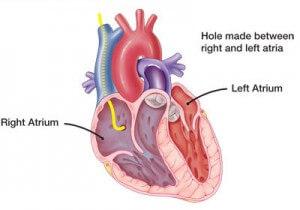Atrial septostomy is a procedure where a small hole is made in the wall between the left and right atria of the heart. The hole can be made using a cardiac catheter (a thin flexible tube, which is inserted into the chambers or blood vessels of the heart).
Atrial septostomy reduces the pressure in the right side of the heart, allowing the heart to pump more efficiently. This improves blood flow to the lungs.

Some people with PH faint occasionally when there is a sudden increase in pressure in the lungs. Making a small hole in the septum (wall), between the right and left atria (atrial septostomy) can help fainting. The hole acts as a safety valve to let the right heart ‘decompress’ when the pressure increases suddenly. This reduces the chances of fainting.
Atrial septostomy can also be useful in people with advanced PH because it reduces pressure in the right side of the heart.
The impact of atrial septostomy on long term survival has not yet been established in clinical trials. The procedure is so rarely performed that is has not even been included in the latest international treatment guidelines.